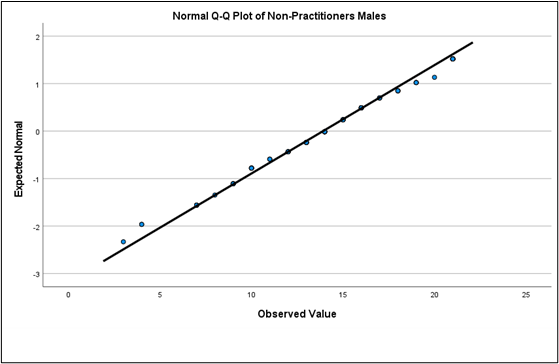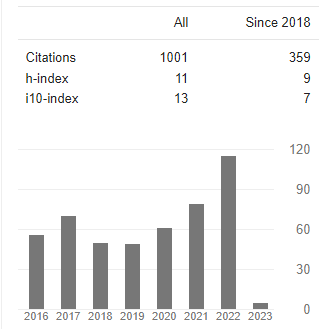Impact of Sahaja Yoga Meditation on Equality in Relation to Gender
Abstract
The present study investigated the significant impact of SYM on gender equality by examining its influence on psychological constructs such as self-awareness, emotional regulation, and stress resilience. Gender equality, a pivotal component of social justice and sustainable development, necessitates not only structural reforms but also psychological and behavioural shifts that challenge entrenched biases.
The study employed a 2 x 2 factorial design to assess and study the significant impact of SYM on the perception the selected variable named equality among 400 participants from Chhattisgarh, stratified by gender (male and female) and meditation practice (practitioners and non-practitioners). Participants with a minimum of five years of consistent SYM practice were selected, ensuring homogeneity in meditative experience. The Sustainable Development Survey Scale (SDSS) was utilized to measure perceived freedom, an essential indicator of gender parity. Data were analysed using a two-way factorial ANOVA to determine and to find out the main effects of meditation and gender, also their interaction effects on equality perceptions.
Findings revealed that SYM practitioners, irrespective of gender, exhibited significantly higher equality perceptions compared to non-practitioners, indicating the meditation’s role in fostering an egalitarian mindset. Female practitioners demonstrated a marginally greater inclination toward gender equity in comparison to their male counterparts, suggesting potential gender-specific benefits of SYM in challenging social conditioning. Furthermore, neurophysiological insights suggest that SYM enhances prefrontal cortex activation, reducing implicit biases and fostering inclusive social attitudes. The Vishuddhi and Agnya chakras, associated with communication and perception, play a critical role in dismantling prejudices and promoting collective harmony.
These findings underscore SYM’s potential as an intervention for advancing gender equality by cultivating cognitive flexibility, empathy, and self-awareness. The study highlights the necessity of integrating meditative practices into educational and policy frameworks to complement structural efforts aimed at gender equity. Future research should explore the intersection of SYM with neuropsychology and gender studies to develop holistic interventions for fostering societal transformation.
Downloads
References
Bennetts, A. (2022). How does yoga practice and therapy yield psychological benefits? A review and model of transdiagnostic processes. Complementary Therapies in Clinical Practice, 46, 101514. https://doi.org/10.1016/j.ctcp.2021.101514
Choudhary, R. (2011). The Sahaja Yoga Meditation and Life Style. Germany: LAMBERT Academic Publishing GmbH & Co. KG.
Choudhary, R. (2012). Effect of sahaja yoga meditation on the alcohol and drug assessment of university students. Recent trends in physical education and sports: and overlook (pp. 13-24) Manipur, S. G. G. S. Khalsa college.
Choudhary, R. (2015). Sahaja yoga meditation: means for activating Kundalini: The spiritual power along with physiological and physiological changes. Proceedings of international conference on tantra,sharir, Kundalini yoga, and psychosomatic disorders (pp. 06-07), IMS, BHU,Varanasi.
Chung, S.-C., Brooks, M. M., Rai, M., Balk, J. L., & Rai, S. (2012). Effect of Sahaja Yoga Meditation on Quality of Life, Anxiety, and Blood Pressure Control. The Journal of Alternative and Complementary Medicine, 18(6), 589–596. https://doi.org/10.1089/acm.2011.0038
Domingo-Echaburu, S., Dávalos, L. M., Orive, G., & Lertxundi, U. (2021). Drug pollution & Sustainable Development Goals. Science of The Total Environment, 800, 149412. https://doi.org/10.1016/j.scitotenv.2021.149412
Dr. Mandeep Singh, 2017. “A study of awareness of inhouse doping errors among national level players and sports administrators in J&K state of India”, International Journal of Current Research, 9, (01), 45226-45227. http://www.journalcra.com/sites/default/files/issue-pdf/20036.pdf
Dr Rajeev Choudhary, & Dr Rajat. (2016). The effects of Sahaja Yog practice and pranadharna practice on dynamic balance ability. International Journal of Physical Education, Sports and Health 2016, 3(5), 76–78.
Dr. Rajeev Choudhary. (2011). Effect of Sahaja Yoga Meditation on the Nutritional Assessment of University Students. International Journal of Sports Science and Engineering, 05, 77–84.
Dr. Rajeev Choudhary. (2024). The Scholarly Landscape of Sahaja Yoga Meditation and Meditation Studies: A Bibliometric Analysis. International Journal of Physical Education & Applied Exercise Sciences, 10(1), 5–12.
Govindaraj, R., Karmani, S., Varambally, S., & Gangadhar, B. N. (2016). Yoga and physical exercise – a review and comparison. International Review of Psychiatry, 28(3), 242–253. https://doi.org/10.3109/09540261.2016.1160878
Hendriks, T. (2018). The effects of Sahaja Yoga meditation on mental health: a systematic review. Journal of Complementary and Integrative Medicine, 15(3). https://doi.org/10.1515/jcim-2016-0163
Hendriks, T., Pritikin, J., Choudhary, R., & Danyluck, C. (2021). Exploring the Relationship Between Character Strengths and Meditation: A Cross-Sectional Study Among Long-Term Practitioners of Sahaj Yoga Meditation. International Journal of Applied Positive Psychology. 7. 31-45. https://doi.org/10.1007/s41042-021-00052-0
Jackson, S., Brown, J., Norris, E., Livingstone-Banks, J., Hayes, E., & Lindson, N. (2022). Mindfulness for smoking cessation. Cochrane Database of Systematic Reviews, 2022(4). https://doi.org/10.1002/14651858.CD013696.pub2
Mandeep Singh Nathial, Analysis of set shot in basketball in relation with time to perform the course and displacement of center of gravity, American Journal of Sports Science, Vol.2 Issue.5 pp: 122-126 (2014). Retrieved from https://www.sciencepublishinggroup.com/journal/paperinfo.aspx?journalid=155&doi=10.11648/j.ajss.20140205.13
Mandeep Singh (2010). Evaluation And Improvement Of Sports Techniques Through Biomechanical Updated Analyzing Technology, University News, Journal of Higher Education Association of Indian Universities, Association of Indian Universities, Vol:48:Issue.05;2010 Pp45-57, 2010
Mandeep Singh Nathial, A Study of Adjustment and Emotional Intelligence of University Coaches in India, American Journal of Applied Psychology. Volume 3, Issue 6, November 2014 , pp. 122-126. doi: 10.11648/j.ajap.20140306.11
Mandeep Singh, 2019; “Effect of Mobile Screen Psychomotor Digital Image Motivators in Person Technique in Reducing Anxiety Level of Intervarsity Players of Cluster University Jammu, Blue Eyes Intelligence Engineering and Sciences Publication (BEIESP). Volume-9 Issue-1, October 2019, PP: 3750-3752, DOI: 10.35940/ijeat.A9811.109119. https://www.ijeat.org/portfolio-item/A9811109119/
Mandeep Singh. (2018). THE AWARENESS OF MOVEMENT AND FITNESS SCIENCES AMONG SCHOOL, UNDER GRADUATE AND POST GRADUATE LEVEL STUDENTS: EMPOWERING EDUCATION THROUGH PHYSICAL EDUCATION. European Journal of Physical Education and Sport Science, 4(3).https://doi.org/10.5281/zenodo.1218149
Mandeep Singh Nathial, Analysis of set shot in basketball in relation with time to perform the course and displacement of center of gravity, American Journal of Sports Science, Vol.2 Issue.5 pp: 122-126 (2014). Retrieved from https://www.sciencepublishinggroup.com/journal/paperinfo.aspx?journalid=155&doi=10.11648/j.ajss.20140205.13
Mandeep Singh (2010). Evaluation And Improvement Of Sports Techniques Through Biomechanical Updated Analyzing Technology, University News, Journal of Higher Education Association of Indian Universities, Association of Indian Universities, Vol:48:Issue.05;2010 Pp45-57, 2010
Mandeep Singh Nathial, A Study of Adjustment and Emotional Intelligence of University Coaches in India, American Journal of Applied Psychology. Volume 3, Issue 6, November 2014 , pp. 122-126. doi: 10.11648/j.ajap.20140306.11
Mandeep Singh., Assessment of Vocational Interests of Pahadi&Bakarwal School Students In Relation To Their Gender. Int J Recent Sci Res. 9(3), pp. 24817-24819. DOI: http://dx.doi.org/10.24327/ijrsr.2018.0903.1731
Manocha, R., Black, D., Sarris, J., & Stough, C. (2011). A Randomized, Controlled Trial of Meditation for Work Stress, Anxiety and Depressed Mood in Full-Time Workers. Evidence-Based Complementary and Alternative Medicine, 2011, 1–8. https://doi.org/10.1155/2011/960583
Mohammad, A., Thakur, P., Kumar, R., Kaur, S., Saini, R. V., & Saini, A. K. (2019). Biological markers for the effects of yoga as a complementary and alternative medicine. Journal of Complementary and Integrative Medicine, 16(1). https://doi.org/10.1515/jcim-2018-0094
Nanda, Y., Kadiyan, N. & Choudhary, R. (2013). Effect of Sahaja Yoga on Self Care. CAPITAL: Research journal of physical education and sports sciences. 1 (2), 111-116.
Nathial, Mandeep Singh. A COMPARATIVE AND ANALYTICAL STUDY OF SELF-ESTEEM AND JOB SATISFACTION IN ATHLETES AND NON ATHLETES. Journal of Advances in Social Science and Humanities, 2(10).https://doi.org/10.15520/jassh210123
Nathial, Mandeep Singh. A COMPARATIVE AND ANALYTICAL STUDY OF SELF-ESTEEM AND JOB SATISFACTION IN ATHLETES AND NON ATHLETES. Journal of Advances in Social Science and Humanities, 2(10).https://doi.org/10.15520/jassh210123
Parris, T. M., & Kates, R. W. (2003). Characterizing and measuring sustainable development. Annual Review of Environment and Resources, 28(1), 559–586. https://doi.org/10.1146/annurev.energy.28.050302.105551
Pavlov, S. V., Reva, N. V., Loktev, K. V., Korenyok, V. V., & Aftanas, L. I. (2015). Impact of long-term meditation practice on cardiovascular reactivity during perception and reappraisal of affective images. International Journal of Psychophysiology, 95(3), 363–371. https://doi.org/10.1016/j.ijpsycho.2015.01.002
Perez-Diaz, O., Barrós-Loscertales, A., Schjoedt, U., González-Mora, J. L., Rubia, K., Suero, J., & Hernández, S. E. (2023). Monitoring the neural activity associated with praying in Sahaja Yoga meditation. BMC Neuroscience, 24(1), 61. https://doi.org/10.1186/s12868-023-00828-x
Pooja Sonkar, & Dr. Rajeev Choudhary 2. (2024). Impact of sahaja yoga meditation on intelligence in relation to different age groups. International Journal of Physical Education & Applied Exercise Science, 19(1), 1–4.
Rajak, B. & Choudhary, R. (2016). Effect of Sahaja Yog Meditation and pranadharana on reaction time of university female students. International Journal of Applied Research. 2(5), 1025-1028.
Rajak, B. & Choudhary, R. (2016). The effects of Sahaja Yog practice and pranadharna practice on dynamic balance ability. International Journal of Physical Education, Sports and Health, 3(5), 76-78.
Rathor, N., Kulshreshtha, P., Mundra, G., Tiwari, R. K., Singh, S., Shah, P., & Sahajayogi, S. (2020). A Study to Evaluate the Effect of Sahaja Yoga Meditation on General Health, Emotional Wellness and Behavior Pattern on College Students. Scholars Journal of Applied Medical Sciences, 08(03), 811–815. https://doi.org/10.36347/sjams.2020.v08i03.009
Ross, A., & Thomas, S. (2010). The Health Benefits of Yoga and Exercise: A Review of Comparison Studies. The Journal of Alternative and Complementary Medicine, 16(1), 3–12. https://doi.org/10.1089/acm.2009.0044
Rubia, K. (2009). The neurobiology of Meditation and its clinical effectiveness in psychiatric disorders. Biological Psychology, 82(1), 1–11. https://doi.org/10.1016/j.biopsycho.2009.04.003
Singh V., Singh G. K. & Choudhary, R. (2012). A study of trend of the effect of sahaja yoga meditation on rhythmic ability. Indian journal of physical education and yogic sciences. 2(2), 46-51.
Singh, M., Kadhim, M.M., Turki Jalil, A. et al. A systematic review of the protective effects of silymarin/silibinin against doxorubicin-induced cardiotoxicity. Cancer Cell Int 23, 88 (2023). https://doi.org/10.1186/s12935-023-02936-4 https://cancerci.biomedcentral.com/articles/10.1186/s12935-023-02936-4
Singh, M., Kour, R., & Kour, A.,. A collaborative diversified investigation of respective responses of sports person coaches and organizations on criminalization of doping.International Journal of Health Sciences,6(S3), 11295–11310. https://doi.org/10.53730/ijhs.v6nS3.8641

Copyright (c) 2025 Rajeev Choudhary

This work is licensed under a Creative Commons Attribution 4.0 International License.














